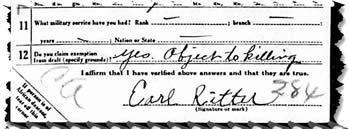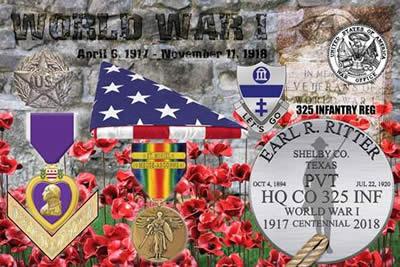August 23, 2017 -
 Earl Rolien Ritter
Earl Rolien Ritter
World War I Veteran
Wounded in Action
"I was worried clean through. I didn't want to go and kill. I believed in my Bible."…. Alvin York, Medal of Honor Winner, World War I.
During the World War, what we know today as conscientious objector status did not exist and it did not exempt anyone from the military as one of the most highly decorated soldiers, Alvin York found out. On June 5th, 1917 on the first national registration day Mr. York answered the question on the form “Do you claim exemption from draft (specify grounds) by writing “Yes. Don’t Want To Fight”.1
On that very day in Joaquin, Shelby County Texas 21-year old Earl Ritter filled out his draft registration and to that same question he wrote “Yes, object to killing”.2 He signed it and gave the form to Mr. A. W. Harrison who also signed it as the registrar. I assume Earl then traveled back to his father’s farm near Joaquin and went back to work.
Earl had always been a country boy, born in October 1894 at Paul’s Store, Texas that was also known as Terrapin Neck. He was the fourth of twelve children born to William “Bill” Frank Ritter (1861-1902) and Minnie Priestly-Ritter (1868-1929).
 After the draft registration life went on as usual for the next four months until October 1917 when Earl received his draft notice and then traveled to the County Seat of Center and was inducted into the Army on the eighth. Initially assigned to Company A of the 306th Infantry Regiment, Camp Mills, New York on April 25, 1918, he found himself on the British ship HMS Karmala departing New York Harbor with Headquarters Company of the 325th Infantry Regiment. Private Earl Ritter who didn’t want to kill was on his way to the World War in France at the age of 23.
After the draft registration life went on as usual for the next four months until October 1917 when Earl received his draft notice and then traveled to the County Seat of Center and was inducted into the Army on the eighth. Initially assigned to Company A of the 306th Infantry Regiment, Camp Mills, New York on April 25, 1918, he found himself on the British ship HMS Karmala departing New York Harbor with Headquarters Company of the 325th Infantry Regiment. Private Earl Ritter who didn’t want to kill was on his way to the World War in France at the age of 23.
3Upon arrival, the 325th entered training and waited to be committed to the Meuse-Argonne Offensive. On October 10th, the regiment attacked to seize the Cornay Ridge, then continued the attack across the Aire River. Eighteen days later Private Ritter was severely wounded in action by shrapnel and it is also believed that he had been effected by gas used by the German Army.
He stayed the course after medical treatment and was with his unit when they boarded the troopship USS Harrisburg and arrived in Hoboken, New Jersey on April 21st, 1919 five months after the armistice. Another month would pass before he was honorably discharged, somehow with no disability. He was awarded the Wound Chevron (Purple Heart), World War I Victory Medal with two battle clasps and the honorable discharge lapel pin.
 4Wasting no time, he married Miss Fannie Todd of Shreveport, Louisiana on June 16th, 1919, six days after discharge. They made their home in Shreveport at 311 Louisiana Street where thirteen months later he became very ill. Mr. Ritter passed at his home at 2:10 a.m. on July 22nd, 1920 at the age of 25. His obituary written by “A Friend” appeared in the Times, Shreveport, Louisiana on Sunday, August 15th, 1920. The friend said in part “the Death Angel took from their home a kind and loving husband. Mr. Ritter lived a Christian life from boyhood and when Uncle Sam called for men, he entered the service. He was only ill five days and his death was quite a shock to his many friends. He was a member of the Christian Church at Eagle Mills, Texas. He was loved by all who knew him; was a kind and loving husband, and a true and affectionate son. A few hours before his death he called his wife and relatives to his bedside and with arms around his wife, told her he was going to Heaven and for her to meet him there, that they would not have long to wait, for the time she had to spend on this earth was only a very little while in comparison with eternity. Mr. Ritter was a man of cheerful temperament and a wonderful personality, always having a smile and kind word for everyone. His many friends extend to the bereaved family their deepest sympathy”.
4Wasting no time, he married Miss Fannie Todd of Shreveport, Louisiana on June 16th, 1919, six days after discharge. They made their home in Shreveport at 311 Louisiana Street where thirteen months later he became very ill. Mr. Ritter passed at his home at 2:10 a.m. on July 22nd, 1920 at the age of 25. His obituary written by “A Friend” appeared in the Times, Shreveport, Louisiana on Sunday, August 15th, 1920. The friend said in part “the Death Angel took from their home a kind and loving husband. Mr. Ritter lived a Christian life from boyhood and when Uncle Sam called for men, he entered the service. He was only ill five days and his death was quite a shock to his many friends. He was a member of the Christian Church at Eagle Mills, Texas. He was loved by all who knew him; was a kind and loving husband, and a true and affectionate son. A few hours before his death he called his wife and relatives to his bedside and with arms around his wife, told her he was going to Heaven and for her to meet him there, that they would not have long to wait, for the time she had to spend on this earth was only a very little while in comparison with eternity. Mr. Ritter was a man of cheerful temperament and a wonderful personality, always having a smile and kind word for everyone. His many friends extend to the bereaved family their deepest sympathy”.
Private Earl Ritter didn’t want to kill but still served his country when asked. Probably, he did kill and in doing so I believe the injuries he received in combat contributed to his own death. His friend who wrote the obituary included this short poem “Through the Valley of Sorrow, to Heart-break Hill with burdened hearts they came that day, for a long-loved form, and a dear, dear face, all in a coffin lay.” He is buried in the Joaquin Cemetery, Joaquin, Texas.
(Sources: 1Capozzola, 2008, p. 68, includes a photograph of York's Registration Card from the National Archives; 2Registration Card # 233 Ancestry.com July 2017; 3wikipedia.org/wiki/325_Infanty_Regiment; 4Newspapers.com, The Times, Shreveport, Louisiana, August 15, 1920; Find A Grave Memorial 84290234; Ancestry.com July, 2017; Newspapers.com, El Paso Herald, December 23, 1918.)









